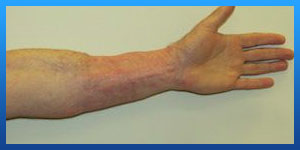Phalloplasty Recovery
Phalloplasty Recovery Time
Phalloplasty, also known as “bottom surgery,” is a complicated, multi-stage surgery that creates or recreates the penis using tissues from other parts of the body.1 Recovery from phalloplasty takes at least six months—in most cases, a year or more is expected—and there’s a significant chance of complications.
This is a period of close monitoring, follow-up appointments, and physical therapy; there may be emotional and psychological effects to take on as well. Phalloplasty is most often used for gender confirmation. If you’re considering or having phalloplasty, it’s important to understand as much as you can about recovery.ee.
Recovery after phalloplasty
Surgery Follow-Up
Phalloplasty is a complex and highly invasive procedure, with recovery in the hospital taking at least four days. The chances of complications following this surgery are relatively high, and follow up appointments will certainly be required. In addition, you’ll require physical therapy and will need to keep certain considerations in mind at home.

Read more about : Phalloplasty Success Rate
What does a follow-up plan look like for phalloplasty?
Recovery at Home
For the first three to five days back home from phalloplasty, make sure to have a family member, friend, or professional to serve as a caregiver. You’ll also need help with lifting, laundry, cleaning, meal preparation, and other household errands for at least three to four weeks after surgery.
First Follow-Up
When you leave the hospital, you will still have two catheters that allow you to urinate without using your urethra. At one week after discharge—during the first follow-up appointment—one of these catheters known as a Foley catheter, is removed.
The doctor checks to ensure that both the site of transplant and the donor tissue area (usually the forearm, inner thigh, or side of the back) are healing well and are not infected.
Read more about : Peyronie’s disease Natural Treatment
Six-Week Follow-Up
Typically, the second catheter, a suprapubic catheter, is left in place for six weeks following surgery. At a second follow up appointment, this catheter is removed. Again, the doctor will also need to ensure that both transplant and donor graft sites are healing well.
Subsequent Follow-Up Appointments
It very much depends on the individual case, as well as the stage of progression, but subsequent appointments may be scheduled every three to six months for a year or more.
Physical Therapy
An essential component of recovery will be physical therapy; this will focus on ensuring motion in donor sites (especially the forearms), and helping you restore walking and lower body strength.
This usually starts three weeks after surgery and continues until there’s an improvement, so total duration varies. Forearm grafts require two to three months of work, whereas total treatment may take much longer.
During your recovery, keep an eye on how you’re feeling and don’t hesitate to let your doctor know if you’re feeling pain, discomfort, or anything seems awry.
Phalloplasty Recovery Timeline
As with all major surgeries, it will take some time before you’re fully recovered and can resume your typical lifestyle. It’s important to note that phalloplasty is always catered to your individual case, and there will always be some variation in terms of healing and rehabilitation.
However, there are guidelines for what you can expect to be able to do as you recover:4
The First Week
For the first week at home, it’s best to take sponge baths rather than showers if possible. If you do shower, keep a bag over grafted areas (such as the forearm, thigh, or side of the back) to keep them dry.
Be very careful in this time; keep your penis elevated, and do not bend, kink, or sit on it. In the early going, note that you should not be lifting any objects over 5 pounds, taking part in exercise, or straining or bending.
Through Week Three
Through the first three weeks, you’ll want to stay very limited in terms of physical activities as laid out above, but there are a couple of changes you’ll start to see. After one to two weeks, you’ll usually be able to take the dressing off skin grafts.
Four Weeks
If you’re a smoker, you’ll be asked to abstain for at least a month before surgery and to stay off nicotine for at least one month following surgery. Tobacco use can seriously hinder your body’s ability to heal from the operation.
Six Weeks and Beyond
While it may vary, it takes six weeks before you can resume normal, day to day activities such as driving, as well as strenuous exercise, biking, swimming, and sexual activities.
With the latter, be careful and patient; you’ll certainly notice changes in your sexuality, the sensations you feel, as well as your experience of pleasure. Communicate with your partner or partners, don’t be afraid to stop (especially if there’s pain or discomfort), and make sure to screen for sexually transmitted diseases if you’re active.
The key during recovery is to be safe and not to rush. Clear any activities you’d like to do or start again with your doctor. If something hurts or anything seems off, stop whatever you’re doing and seek help.
Coping With Recovery
Given how life-altering this surgery can be—whether it’s performed as part of gender confirmation or not—it’s little wonder that patients may face a range of physical and mental health challenges following phalloplasty.
While initial recovery is expected in about six weeks, complete rehabilitation is a much longer process that can take 12 to 18 months.5 The keys to coping involve managing pain, especially in the early going, and taking on any psychological fallout from the procedure.
What should you keep in mind when coping with your recovery? Here’s a quick breakdown.
Pain Management
Following a surgery of this scale, you’ll certainly feel some pain and discomfort. You’ll be prescribed strong painkilling medications and will need to carefully take these, with the idea that you taper these off as the condition improved.
In addition, you should refrain from taking non-steroidal anti-inflammatory (NSAID) drugs, such as ibuprofen, aspirin, or Aleve, for the first seven to 10 days, or any Tylenol while on prescribed pain medication.
Other Medications
Alongside your painkillers, you’ll also need other prescribed pills to help aid in recovery. These may include stool softeners, anti-nausea medications, antibiotics, as well as prescription-strength aspirin. Make sure to learn as much as you can about how to take these and how they work and be mindful of side-effects.
Mental Health
Especially when phalloplasty is a part of gender confirmation, this surgery can have a major impact on mental health. People may feel depression, anxiety, fear, or other emotions in the time after surgery.
Assessment of mental health is an integral part of the post-operative plan and a feature of follow-up visits. In many cases, primary care doctors will refer people to counselors specialized in gender transition and related mental health.
Wound Care
Ensuring that the site of transplant and donor skin graft areas heal properly is absolutely essential to the success of phalloplasty. As noted, the risk of complications is acute for this procedure, and you’ll get a great deal of education about how to ensure safe recovery and rehabilitation of these regions.
How do you go about ensuring your donor skin graft heals properly? Typically, the guidance is as follows.
Weeks One and Two
During the first two weeks following surgery, if the donor site is on the forearm, you’ll need to change the dressing on the graft once a day. As you remove old bandages, keep an eye out for blisters or portions of skin graft coming off.
If the donor site is on the inner thigh, use only Xeroform bandages and don’t remove the dressing, as this dries and flakes off on its own. As the wound is healing, don’t put any moisturizers, creams, or other products on it, and avoid getting skin grafts wet.
Week Three
With your doctor’s OK, during the third week you should be able to stop dressing the arm and leave the graft open to the air. At this point, you may be instructed to start massaging the area, and you can start using moisturizers or other products.
Beyond Three Weeks
Largely the physical healing from the surgery occurs during the first three weeks. As mentioned, you may require physical therapy to restore motion and strength in grafted areas. Throughout the recovery period, let your doctor know if there are any signs of infection, including swelling, redness, fluid discharge, or fever.
Penis Care
And what should you keep in mind when caring for your penis? This is a little more involved and entails:
. Keep elevated: Following the operation when you’re still in the hospital, you’ll receive education about how to keep your penis elevated. This will involve using special dressing to keep it in place.
. Support: Make sure to wear supportive underwear when walking and do what you can to keep the area stable. Do not bend, kink, or sit on the penis.
. Careful sitting: Make sure that you’re not flexing your hips more than 90 degrees when sitting. Also, make sure not to pull your thighs into your chest as this restricts blood flow.
. Ointment: Twice a day, you should apply bacitracin ointment to the wounds on your penis.
. Abstain from sex: Until you have your doctor’s OK (usually at about six weeks post-surgery) you should abstain from any sexual activity involving the penis. Be careful and patient as you start becoming sexually active; you’ll notice changes in your sexuality, sensations, and experience pleasure following phalloplasty.
. Monitoring: Alongside your doctor, you should be closely monitoring your penis for signs of infection or other problems. If there is a change of color, it feels hotter or cooler than normal, or if there’s swelling or drainage, let your doctor know immediately.
It may take longer—sometimes up to a year—for the new penis to develop sensation, so be mindful and careful about sex.
Keep up with this guidance and don’t stop until you get your doctor’s OK. Keep in mind that recovery from phalloplasty varies from person to person, and there may be more specific instructions if you’ve had additional work, such as implanting a device for erections, or scrotoplasty, the addition of a scrotum.
Source:
https://www.verywellhealth.com/phalloplasty-recovery-5077958


